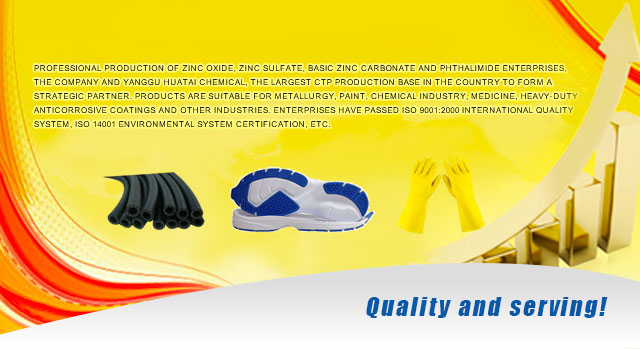版权信息
ICP:鲁ICP备13030474号-1 Powered by www.300.cn
Nano zinc oxide
Nano-ZnO (ZnO) with a particle size between 1-100 nm is a high-end, highly functional, fine inorganic product that exhibits many special properties such as non-migratory, fluorescence, piezoelectricity, absorption and scattering. UV sensor, etc., using its wonderful properties in light, electricity, magnetism, sensitivity, etc., can produce gas sensors, phosphors, varistors, UV shielding materials, image recording materials, piezoelectric materials, varistors, high-efficiency catalysts, magnetic properties. Materials and plastic films, etc. Microscopic changes Many people do not see the excellent properties of nanomaterials. Through practice, nano zinc oxide is now more and more widely used in various fields such as rubber.
Rubber industry
It has large specific surface area and stronger activity. It can be used as a functional additive such as vulcanization active agent to improve the performance of rubber products such as smoothness, wear resistance, mechanical strength and anti-aging performance, reduce the use of ordinary zinc oxide and prolong the service life;
Ceramic industry
As a enamel glaze and flux, it can reduce sintering temperature, improve gloss and flexibility, and has excellent performance.
Power Electronics
The non-linear characteristics of the nano zinc oxide varistor enable it to provide overvoltage protection and lightning strike resistance, [1] the role of transient pulse, and become the most widely used varistor material. The research proves that the nonlinear coefficient of the nano zinc oxide varistor for the arrester is α=45, the critical electric field value is greater than 1000V, and the leakage current is less than 1μA.
Defense industry
Nano-zinc oxide has strong ability to absorb infrared rays, and has a large ratio of absorption rate to heat capacity. It can be applied to infrared detectors and infrared sensors. Nano-zinc oxide also has the characteristics of light weight, light color and strong absorbing ability. Effectively absorb radar waves and attenuate them for use in new types of absorbing stealth materials;
Since the discovery of carbon nanotubes in 1991, low-dimensional nanomaterials (such as linear, ribbon, rod and tubular) have attracted much attention due to their unique properties and potential applications in nanodevices. Zinc oxide (ZnO) is an important optoelectronic semiconductor material with a wide band gap (3137 eV) and large exciton binding energy (60 meV) at room temperature, and is widely used in photodiodes, [2] sensors. The discovery of varistor and photodetector, especially the room temperature ultraviolet light emission phenomenon of ZnO nanostructures, makes ZnO become the research point of short-wave semiconductor laser device materials again.
Textile industry
It has good UV shielding property and superior antibacterial and antibacterial properties. It can be added into fabrics to impart functions such as sun protection, antibacterial and deodorization.
Feed industry
As a kind of nano-material, nano-zinc oxide has the characteristics of high biological activity, high absorption rate, strong anti-oxidation ability, safety and stability, and is the most ideal zinc source. The replacement of high zinc with nano zinc oxide in the feed can not only solve the zinc demand of the animal body, but also reduce the pollution to the environment. The use of nano-zinc oxide can play the role of antibacterial and antibacterial, while improving animal performance;
Coatings and other fields
Metal oxide powders such as zinc oxide, titanium dioxide, silicon dioxide, aluminum oxide, magnesium oxide, etc., when these powders are made into nanometer scale, the size of the particles is equivalent to or smaller than the light wave, and the conduction band is caused by the size effect. As the interval between the valence bands increases, the light absorption is significantly enhanced. Various powders have different differences in light shielding and reflection efficiency. When zinc oxide and titanium dioxide are compared, when the wavelength is less than 350 nm (UVB), the shielding efficiency is similar, but at 350-400 nm (UVA), the shielding efficiency of zinc oxide is significantly higher than that of titanium dioxide. At the same time, the refractive index of zinc oxide (n=1.9) is smaller than that of titanium dioxide (n=2.6), and the diffuse reflectance to light is low, which makes the fiber transparency higher and is advantageous for textile dyeing.
Nano-zinc oxide can also be used to make far-infrared reflective fiber materials, commonly known as far-infrared ceramic powder. The far-infrared reflective functional fiber absorbs the heat emitted by the human body and radiates far-infrared rays of a certain wavelength range to the human body, in addition to increasing the blood flow in the subcutaneous tissue of the human body, promoting blood circulation, and shielding infrared rays. The heat loss is reduced, so the fiber is more thermally insulated than the general fiber.
|
project |
specification |
||
|
|
standard |
Test results |
Detection method |
|
ZnO % |
≥95.00 |
96 |
According to GB/T19589-2004 (nano zinc oxide) Standard test |
|
PbO (Pb) % |
≤0.03 |
0.00048 |
|
|
MnO(Mn) % |
≤0.005 |
0.0013 |
|
|
CuO(Cu) % |
≤0.003 |
0.00022 |
|
|
Hydrochloric acid insoluble matter % |
≤0.04 |
0.024 |
|
|
Burning weightlessness % |
≤4 |
2.03 |
|
|
Water soluble % |
≤0.7 |
0.65 |
|
|
105 ° C volatiles % |
≤0.7 |
0.42 |
|
|
Conclusion: After testing, the product meets the requirements of GB/T19589 nano zinc oxide three technical standards. |
|||





